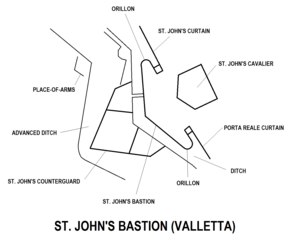Saint John's Cavalier
| Saint John's Cavalier | |
|---|---|
| Kavallier ta' San Ġwann | |
| Part of the fortifications of Valletta | |
| Valletta, Malta | |

Saint John's Cavalier
|
|

Coat of arms of the SMOM
|
|

Map of St. John's Bastion with its cavalier and counterguard
|
|
| Coordinates | 35°53′50.15″N 14°30′31.53″E / 35.8972639°N 14.5087583°E |
| Type | Cavalier |
| Site information | |
| Owner | Government of Malta |
| Controlled by |
|
| Open to the public |
No |
| Condition | Intact |
| Site history | |
| Built | 1560s |
| Built by | Order of Saint John |
| Materials | Limestone |
Saint John's Cavalier (Maltese: Kavallier ta' San Ġwann) is a 16th-century cavalier in Valletta, Malta, which was built by the Order of St. John. It overlooks St. John's Bastion, a large obtuse-angled bastion forming part of the Valletta Land Front. St. John was one of nine planned cavaliers in the city, although eventually only two were built, the other one being the identical Saint James Cavalier. It was designed by the Italian military engineer Francesco Laparelli, while its construction was overseen by his Maltese assistant Girolamo Cassar.
The cavalier is located close to the City Gate Arcade and Hastings Gardens. Today, the cavalier is the embassy of the Sovereign Military Order of Malta, the successor of the Order who built it in the first place.
Following the Great Siege of Malta of 1565, in which the Ottoman Empire attempted to take over Malta but failed to do so, the Order of St. John decided to settle permanently on the island. The Order decided to build a new fortified city as their new capital, and it was called Valletta after Grand Master Jean Parisot de Valette. In order to do this, De Valette asked for financial aid from various European rulers. Pope Pius V not only helped out financially, but he also sent the Italian military engineer Francesco Laparelli to Malta in order to design the new capital's fortifications. Construction of the city began in March 1566, and work continued throughout the 1570s. Following Laparelli's departure from Malta and his subsequent death, construction of the city was entrusted to his Maltese assistant, the architect and military engineer Girolamo Cassar.
...
Wikipedia
